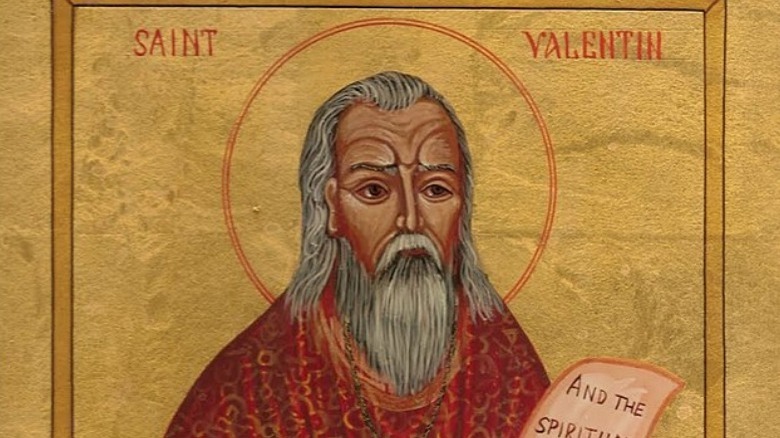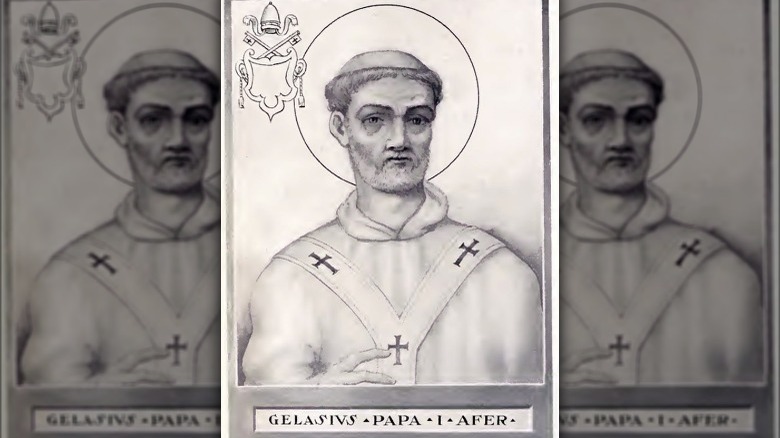A Short History Of Valentine's Day
Amid celebrations of love, romance, and chocolate, Valentine's Day is often perceived as a corporate holiday by brands selling cards, jewelry — and, yes, chocolate. Indeed, according to the National Retail Foundation, in 2022, Americans planned to spend about $175 on average, with men saying they'd drop $235 on Valentine's Day gifts while women only reported thinking they'd spend about $119. Nationally though, Valentine's Day spending in the United States was expected to be nearly $24 billion, down from 2020's record of just over $27 billion. Does any part of that sound romantic? Perhaps not. So, what's the real story, then?
For a number of reasons, the origins of Valentine's Day remain shrouded in mystery. First off, there are three different martyred saints named Valentine in the Christian tradition, via History. And according to the U.K.'s Horniman Museum and Gardens, there was an ancient Norman celebration called Galatin's Day from which modern Valentine's Day may have evolved. That's also not to mention the love-themed Roman celebration called the Feast of Lupercalia which had many Valentine's Day similarities. And what about that little guy with a bow and arrow called Cupid? Though there are varying stories about where Valentine's Day really comes from, here's a closer look at some leading theories.
The story of Saint Valentine
The leading theory of how modern Valentine's Day got started relates to three Christian saints named Valentine, according to the Big Think. One lived in North Africa, one lived in Terni, and one lived in Rome, but they all lived in the third century A.D. The Saint Valentine linked to Valentine's Day was the one who lived in Rome, and was a priest who secretly conducted marriage ceremonies. According to Horniman Museum and Gardens, at that time, Roman Emperor Claudius II had outlawed marriage for young men, as he thought single men made better soldiers. Another legend suggests that Valentine was killed for helping Christians escape from Roman prisons.
Valentine is said to have sent the first "Valentine's card" to a woman who visited him as he awaited execution, signing it "from your Valentine," a phrase found on Valentine's cards today. There's now some disagreement as to whether the Valentine of Terni and the Valentine of Rome might have been the same person (via Italy Heritage). Regardless, Valentine was set up as a heroic, romantic figure in the Middle Ages, and became a beloved saint in both England and France. The third Saint Valentine of North Africa is also said to have been martyred and some think that Pope Gelasius I who, in the fifth century, decreed February 14 Valentine's Day could have been of North African descent, according to Afrik-News.
From goat's blood to poetry
Motivating Gelasius I to declare February 14 Valentine's Day, the Christian church at that time sought to "Christianize" a pagan fertility festival called Lupercalia each February 15, as History notes. During Lupercalia, Roman priests, known as the Luperci, gathered at a sacred cave for a goat and dog sacrifice to encourage fertility and purification. The priests then took to the streets holding strips of goat flesh dipped in sacrificial blood which they then used to slap women and crop fields to encourage high birth rates and good harvests. Lupercalia reportedly ended with women putting their names in an urn. Rome's single men then chose a name from the urn and the couple would spend the next year together, and sometimes marry.
When Pope Gelasius I declared February 14 Valentine's Day, Lupercalia was outlawed. Valentine's romantic connotation began much later, connected possibly to the Medieval belief that bird mating seasons began on the same date. The first mention of Valentine's Day as a celebration of romantic love is thought to have come from Geoffrey Chaucer in this line from the 14th century poem "Parliament of Foules," reading: "For this was sent on Seynt Valentyne's day / Whan every foul cometh ther to choose his mate."
Other written Valentine's greetings appeared in the 15th century. Also according to the Horniman website, there was a love and sex-themed Norman celebration called Galatin's Day — sounding awfully close to Valentine. The two perhaps got confused as time went on.
Cards and Cupid
The oldest Valentine's that still exists is a poem written in 1415 by Charles, Duke of Orleans, to his wife while imprisoned in the Tower of London, per History. That note now resides in the British Library in London. By the middle of the 18th century, it was a common practice for friends and lovers to give tokens of affection or handwritten notes to mark the holiday, as History explains, with printed cards commonly replacing letters by 1900. In the United States, Esther A. Howland is thought to have popularized the ornate and elaborate creations we associate with Valentine's when she made and sold such cards in the 1840s.
It was also around this same time that depictions of the Roman god Cupid, related to the Greek god Eros, became linked with the holiday, as TIME reports. For time immemorial, Cupid and Eros represented love and desire, and with the rise of the Valentine's card industry, Cupid became like a de-facto mascot for the holiday based on Renaissance ideas of what he might look like. Today, Valentine's Day is the second-largest card-sending holiday, after Christmas. Per Hallmark, about 145 million Valentine's Day cards — mass-produced by the industry-leading Hallmark greeting card company since 1916 — are exchanged, not counting cards given by children in classrooms via shoeboxes and handmade mailboxes.



